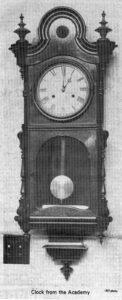June 29, 1978

Picture #1 – Clock from the Academy
Shortly after the Review Times was delivered on Thursday June 15, my telephone started ringing. That day POTLUCK dealt with the history of the old academy and the Ohio Normal college that was once here in Fostoria.
Kenneth “Eck” Thrailkil was the first caller. He informed me he had a clock that was salvaged from the fire that destroyed the college. The accompanying photo shows the old clock, which is 41″ high and 15″ wide. When I visited the Thrailkils it was still ticking away.
The clock was given to him by Professor David Berringer, who was an instructor at the school. He and his family lived at 543 College Ave. Thrailkil doesn’t know what he taught, but remembers that in one room of their home he had a very large collection of rocks, so evidently he was in the natural sciences department.
Their son Kaye Barringer was on one of the Fostoria High football teams. I.C. Boles coached around 1909.
Gerald Windau, who resides at 627 Foster Street, which was once part of College Park, called to express his appreciation of POTLUCK, and that day’s column and then very politely informed me that the boy’s dormitory was also still standing. I had “goofed” when I reported that only the girls’ dormitory remained.
Later, Jack Beatty, who presently owns the building which was once the boy’s dorm, called to discuss the error too. He said that on the third floor of the building he discovered a hanger for a punching bag. Evidently the top floor was used as a recreation area, since it was not partitioned off for sleeping quarters.
The present house numbers for the boys dorm are 632-634, in case readers drive down Foster Street to see the old structure, now nearly 100 years old.
Dan McGinnis at Kaubisch Library informed me that after the Ohio Normal College burned, those who were trying to establish a normal school at Bowling Green seriously considered establishing a school at the College Park site here. It is reported that their interest cooled when the large number of saloons in Fostoria became known.
As readers may know, the Bowling Green normal college eventually became Bowling Green State University. In terms of its size today, think what it would mean to Fostoria.
Iva Beck, a regular POTLUCK reader, reported that Mr. and Mrs. Robert Goodyear own and reside in the house at 531 College Ave., which at the time of the Academy was used as an off-campus dormitory and dining hall.
Gertrude Kassing telephoned to report that her father, William Kassing attended and graduated from the Academy.
I stopped to look at her father’s memoirs…two beautifully hand lettered diplomas, one for penmanship and another for accounting, granted in 1886. Also volumes of The Ohio Educational Monthly and National Teacher, published in 1886-87.
Today’s older, or retired teachers may sanction the following excerpt from an issue, while others may be amazed at the concepts set forth by Dr. J.P. Wickersham, the author.
DISCIPLINE AS A FACTOR IN THE WORK OF THE SCHOOL-RROM
The work of a school may be roughly divided into two parts; first, instruction, and second, discipline. Instruction as we are thinking of it, consists in imparting knowledge and in conducting those educational processes which produce intellectual strength and culture. Discipline in the sense now intended includes both those influences which secure order in a school-room and those forces which tend to awaken and develop the moral nature of the young. In the first, the teacher appears as the builder-up of the mind, an instructor; in the second, as an executive officer administering a system of government.
An end of school discipline is order; but this the least important of its ends, which comprehend in their fullness the high purposes of forming character and shaping life. the custom has been even among the teachers of wide reputation to look upon the discipline of the school rather as a means than as an end. Children in school, they hold, must be orderly or their studies will be interrupted and their progress in learning slow. This view is partially correct, but in our conception it stops at the very beginning. A child attends school certainly not more to learn reading, writing, arithmetic, and other branches of knowledge, than he does to receive proper moral training. Habits like those of order, industry, politeness, if they can be acquired at school, and great principles such as honor, honesty, truthfulness, justice, charity, if they can be implanted in the youthful mind, surely outweigh in educational value any amount of what is called “learning”.
Dr. Wickersham’s presentation contained much more fundamental concepts for teaching and learning, but I believe “nuf sed” to make the point.